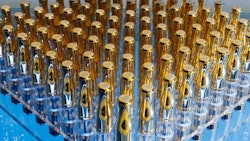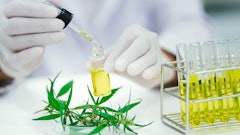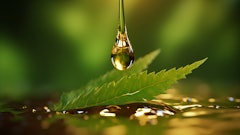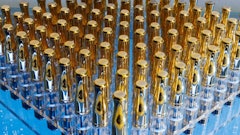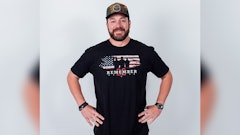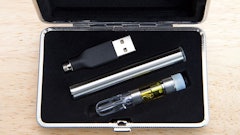
Vape cartridges are rapidly growing more popular with new cannabis consumers, and it’s not difficult to fathom why: They are portable, discreet and usually less pungent than flower. During the first four months of 2018, Californians purchased $165 million worth of vape carts, Coloradans shelled out $62.4 million for them and Oregonians spent $31 million, according to data from BDS Analytics, making cartridges the top-selling product in all three states. Given the hype, let’s examine both cartridges and their contents, as there is a wide range of quality on the market.
Cartridges
While there might be exceptions, cartridges (the vessels holding the cannabis extracts) can largely be categorized as high or low quality.
Typically, low-quality cartridges:
- are made of plastic (terpenes can penetrate plastic, and plastic can potentially leach chemicals from the oil),
- have poor-quality or ill-fitting O-rings that leak; and
- have pre-moistened wicks primed with glycerin or propylene glycol that can cause allergic reactions in some people.
Low-quality cartridges will have a higher customer return rate (if a return policy exists) and will drive away customers who become frustrated with the lackluster experience.
And high-quality cartridges typically:
- are made of premium materials, such as glass, metal and ceramic;
- have properly-sized O-rings; and
- have sealed joints that prevent contact between the air and cartridge contents.
Choose your cartridges wisely and always examine the cartridge’s quality. A low-cost cartridge is not necessarily better for your business, and it alerts the customer that the contents might be poor-quality, too.
The Contents of Your Carts
As consumers become more educated about their options, it is likely they will begin to examine your cartridge’s stated ingredients, the same as they do for food ingredients, ultimately affecting how dispensary purchasing managers approach you. Whether you are vertically integrated or working with a third-party extractor, it’s crucial you know everything about your product. Do you claim to use organic practices or to be chemical free? Do you have certifications proving it? Does your product contain cannabis-derived terpenes, artificial flavors or terpenes derived from other sources? What terpene-isolation method was utilized? If non-cannabis-derived terpenes or artificial flavors were used, what are they, and from where were they sourced? If a purchasing manager asks a question about your product that you cannot answer, you’re in trouble.
Here is a rundown of contents found in typical vape cartridges:
1. Cannabis-derived terpenes: Cannabis terpenes sourced from cannabis.
Full-spectrum in composition, products made with these terpenes contain a high percentage of monoterpenes that have not been oxidized or degraded by heat application.
2. Steam-distilled terpenes: Softer in taste than extracted terpenes that have been isolated without utilizing heat, many steam-distilled terpenes are lost in the water used to produce steam, aka “pot water.”
3. Hydrosols: Hydrosols are a byproduct of steam distillation and low-heat distillations. They are classified as floral waters (i.e., essential oils) and contain only small percentages of actual terpenes. Heat is utilized and degrades the terpenes, too.
4. Non-cannabis-derived terpenes: Terpenes sourced directly from plant leaves, fruits or other organic sources, rather than from cannabis. It is impossible to recreate the aroma or flavor of the original plant/cultivar utilizing terpenes from non-cannabis plants, but a gross approximation can be achieved.
5. Artificial flavors: Typically, the artificial flavors found in cannabis cartridges are sourced from the e-cigarette industry. There are thousands of flavors, but their safety is in question (e.g., diacetyl causing “popcorn lung”).
6. HTFSE (High-Terpene Full-Spectrum Extract): Made from hydrocarbon extraction, there has been a recent trend of producing these products from pressed rosin. Also called sauce, HTFSE has high terpene content and is aromatic and flavorful.
7. CO2 Extracted: Some CO2 extractors collect a few available terpenes from CO2 extraction, but, more often than not, the cannabis product utilized to extract is dried, thus much of the available monoterpenes are lost in the drying process. This will result in a terpene composition that is mostly comprised of basic primary terpenes and low percentages of available monoterpenes. Therefore, both the final aroma and flavor are not as strong as HTFSEs, or if you had utilized a no-heat methodology of terpene isolation.
 newsletter subscribe
newsletter subscribe
Beyond customers and purchasing managers, an important production-related detail to keep in mind is whether the stated THC percentage is measured before or after viscosity adjustment (fine-tuning the oil’s density) with glycerin, glycol and hydrosols. If any of these products were added after lab testing, the stated THC percentage is higher than what the product actually contains, making the stated percentage erroneous and potentially opening you to a lawsuit.
Most quality cartridges contain either CO2, hydrocarbon or distilled extracts, or a combination thereof, and most have flavor added. Some add cannabis-derived terpenes to a distillate to approximate the original characteristics of the plant/cultivar from which it came. This is typically accomplished by adding a fresh-frozen, terpene-rich hydrocarbon extract to a distillate. The resulting extract is flavorful and has a preferred viscosity.
Some utilize steam-distilled cannabis terpenes and hydrosols (a type of floral water), but these often lack monoterpenes (e.g., geraniol, terpineol, limonene, myrcene, linalool, pinene, etc.), which are responsible for the differentiation between cultivars. Some companies claim to re-infuse cannabis terpenes in their products, but said terpenes are often manufactured via low-heat steam distillation (utilizing distilled water and ethanol, or a variation thereof). The oxygen- and water-exposure results in a product with few of the original terpenes.
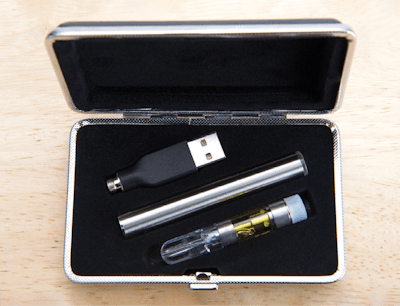
How to Decide
All extracts, isolates and compounds mentioned can be added to a flavorless or close-to-flavorless distillate or extract to increase aroma and flavor. This endless supply of cannabinoid cocktails has led to a great disparity in overall quality with respect to the desirable traits of the original cultivar. What looks low-quality and what is low-quality can be difficult to distinguish.
Some customers choose the clear oil over the dark oil, thinking it is purer and superior; this is generally a good rule of thumb to follow, as a dark oil typically indicates excessive amounts of lipids, fats, wax, or pigments in the product, or improper storage of extract material leading to exposure to air (oxidization), heat (decarboxylation) or a multitude of other factors.
That does not mean all darker colored extracts are inferior. Case in point: If one were to add a HTFSE to a water-clear distillate, it would inevitably add color. The more HTFSE added, the darker the distillate will become. Pressed rosin will impart undesired darker color when added to a clear distillate, yet the flavor profiles it imparts are strong when the rosin is produced at low temperatures (which preserves the available terpenes).
Cannabinoid content is another factor that can be misleading. If a distillate is made up of 95-percent cannabinoids, it contains 5-percent non-cannabinoid content, which can be terpenes, wax, pigments, flavonoids, etc. If a distillate is made up of 99-percent cannabinoids, it obviously has fewer of these non-cannabinoid compounds. While it might sound appealing to the unwitting consumer, a vape pen cartridge that contains 99-percent cannabinoids may not be pleasant to consume because terpenes are what add flavor and aroma.
Having the most potent cartridge at the expense of other desirable attributes may eventually work as a disadvantage for the cartridge producer. A vape cartridge should contain a perfect balance of both cannabinoids and terpenes. Within that larger scope, manufacturers can formulate specific cannabinoid and terpene ratios to cater to customer desires or requests. If a group of customers only wants CBD distillate at 80-percent cannabinoid, 20-percent terpene ratio, with no THC, you will be able to formulate that. If another desires an 80-percent THC cartridge combined with 20 percent terpenes, you can do that too.
Questions Ahead
As we develop new products and formulations within this space, we will also have to wrestle with health and safety concerns. I’ll be the first to admit that there are a lot of unknowns with cannabis. For starters: How much is too much? It’s a simple question, yet there is certainly no easy answer given the vast number of terpenes in cannabis and how they interact with different metabolisms, different body weights and a whole host of other factors that determine what thresholds of terpenes are healthy (or perhaps detrimental) to an individual.
There are even more unanswered questions regarding the medical applications of cannabinoids. What is it about the synergistic effects of cannabinoids, terpenes and the specific blending of the two that can produce the pharmaceuticals of the future? What combinations of cannabinoids and terpenes treat which types of cancer? What combination can be used as a neuroprotectant? Given the worldwide cancer rate, and the worldwide need for neuroprotectants for diseases such as Alzheimer’s and dementia, I believe there is great monetization incentive to develop these drugs.









